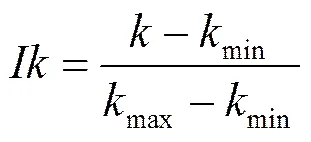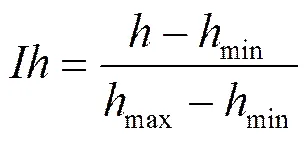Research of a Social and Economic Infrastructure of Regions of China as a Priority Direction of Economic Policy APEC: Some Results.
2015-10-13AngelinaIlchenkoMAJunXIANGXiaogang
Angelina N.Ilchenko, MA Jun, XIANG Xiao-gang
Research of a Social and Economic Infrastructure of Regions of China as a Priority Direction of Economic Policy APEC: Some Results.
Angelina N.Ilchenko1, 2, MA Jun1, XIANG Xiao-gang1
(1. College of Mathematics and Computer Science, Wuhan Textile University, Wuhan Hubei 430073, China;2. School of Management Finance and Information Systems, IvanovoState University of Chemistry andTechnology, Ivanovo 153000, Russia)
Summit APEC (Beijing, November 2014) declared acceleration of development of economy of the countries APR through integration of process of realization of infrastructural projects, both in national and in international scales. In this article, it gives the experimental economic-mathematical modeling of a historical tendency which shows dependence of quality of life of the population and a condition of a social and economic infrastructure of territory are resulted. The information base of research includes the official statistical data during 10 years on an example of several industrial regions of China. Author's mathematical and statistical models reflect the modern scientific approach developed in 2012-2014 in WTU in common Russian and Chinese scientists. Authors hope that the offered scientific techniques can be applied in the conditions of many developing countries APR. Our offers should help to the regional government to define priorities for infrastructural investments.
A social and economic infrastructure; quality of life of the population; the integrated indicator; the factorial analysis; regional economy; a rating of territories; IDSEI
1 INTRODUCTION
The annual meeting of heads of the states-participants of Asian-Pacific Economic Cooperation (APEC) has taken place in Beijing 10 – on November, 11th, 2014. More than 1500 delegates from 21 countries have discussed questions of creation of a regional zone of free trade. Overall objective APEC is increase of economic growth and population prosperity in region. Therefore following the results of the summit the joint declaration reflecting the basic directions and prospects of cooperation is accepted.
The countries of Asian-Pacific Region (APR),as the engine of world economic development, should accelerate carrying out of economic reforms and introduction of innovations.
For the accelerated growth of developing economy it is necessary to promote growth of an employment level of the population. For this purpose to use macroeconomic strategy of creation of new workplaces, it is need to increase professional qualification and training of young experts.
For creation of a high-grade Zone of Free Trade of the country, participants APEC should pay prime attention to development of objects of an infrastructure: transport networks, communications and seaports.
Infrastructural projects play a key role in creation of the Zone of Free Trade: for decrease in trading tariffs, increase in commodity streams, free moving of labour and the capital. Investments into an infrastructure are scale long-term investments and accumulation of great volumes of the finance demand. For assistance to investment process participants of forum APEC have accepted the document – the Road map in which stages of liberalization of an investment climate are defined. The major stage – creation of Investment Fund of Infrastructural Projects in which the Peoples Republic of China puts 40 billion US dollars, and also specialized bank: the Asian Infrastructural Investment Bank with an authorized capital stock of 50 billion US dollars which in 2015 already will begin the servicing, developing countries investing in an infrastructure.
Among the major transnational infrastructural projects: a reconstruction of the Great Silk Way to Europe; building of a through trunk-railway through the countries of Southern Asia; modernization of a railway system of Thailand; a construction of modern seaports at Pacific coast.
Russia is interested in participation in integration projects APR a special role in which play Siberia and the Far East, first of all in power and transport areas. They can become original «the overland bridge» between the countries, a so-called Pacific Ring, and Europe.
The Asian-Pacific Region makes 55 % of world production, has 40 % of the world population and provides 44 % of world trade. Thus the population in the region countries lives in various conditions of quality of life and infrastructural security. The Road map of regional economic integration accepted by summit APEC should promote alignment of living conditions in the different countries.
The countries – leaders on the size of territories: the USA, Canada, the Peoples Republic of China and Russia also have the big distinctions of quality of life in the regions (provinces). The problem of each government is to single level quality of life of the population in all territories. A key to alignment is that it has too infrastructural projects. The government accumulates means and defines priorities for investment. For this purpose it is necessary to know a rating of each territory on a condition of an infrastructure and a degree of quality of life of the population. The territory rating shows the best and worst positions and makes recommendations to the government for prime investments into infrastructural projects. The objective integrated indicator for quantitative and quality standard of many characteristics should be criterion of classification of territories. Such research is spent in WTU at faculty of Mathematics and Computer sciences since 2012.
2 BASIC CONCEPTS
Infrastructure is a relatively abstract concept. In the development process of the state it is generally refers to the means of material engineering facilities to provide public service for the social production and residents’ life. It is the public service system which ensures the economic activities of a nation or region to be normal. It not only includes the foundation construction of the highway, railway, airport, communication, water, electricity gas, etc, which are known as the physica linfrastructure, but also includes education, science and technology, health, sports, culture, etc, which are known as the social infrastructure. There are many papers bout the research of the index of the social and economic infrastructure development and the methods for determination of relative index are various and not unified. Authors firstly construct a new method for the determination of the index of the development of social and economic infrastructure--IDSEI [1, 2, 3].
3 HYPOTHESES AND THE IDSEI MODEL
In the article we should firstly make some assumptions. According to the Statistical Yearbook of Hubei province, Hunan province and Henan province from 2009-2012[4, 5, 6], it is assumed as follows.
We assume

where
. (2)
Furthermore we make more assumptions as follows.
We assume

Where
, (4)
and

We assume

In the whole, it is considered that industrial index is more important than the socially demographic index. From the following assumptions we will know that,,and.
According to the assumptions above, it is necessary to standardize the data. The min-max method is used to normalize the data. It is assumed as follows.

, (8)
The value of regional GDP per capita should firstly use logarithmic treatment and then use min-max method.

, (10)
, (11)

, (13)
, (14)

(16)
4 EXPERIMENTAL MODELING
According to the formulas and assumptions, the data could be processed. The data are as following table 1 to table 3. Data of the variableis the urban residents’ data because of the format of the Statistical Yearbook [4, 5, 6].
Using formula (7)-(16), the data in table 1 could be processed, and we can get the table 2.
Using formula (1)-(6), the data in table 2 could be processed, and we can get the table 3.
Using SPSS software, the data of,andcan be transformed to the figure 1 to figure 3 as follows.
First of all, if we make the simple longitudinal comparison, According to the data and the figure above, we can find that the,andfactor have the upward trend in the whole in spite of the differences between themselves from 2009 to 2012. The minimumin2009 is0.26,and the maximumin 2012 is 0.73 It means that, in central region of china, the socially demographic factors and the industrial factors are the positive and can lead to a better achievement.

Table 1: data of the economic variables mentioned above

Table 2: data of the index of the economic variables mentioned above
Table 3: data of the

Table 3: data of the
yearprovince 2009Hubei0.150.740.54 2009Hunan0.080.660.46 2009Henan0.410.190.26 2010Hubei0.310.690.56 2010Hunan0.170.760.56 2010Henan0.560.200.32 2011Hubei0.470.700.62 2011Hunan0.500.810.70 2011Henan0.660.180.34 2012Hubei0.530.750.68 2012Hunan0.600.800.73 2012Henan0.760.260.43
Secondly, if we make the simple horizontal comparison, we can get some conclusion. For the, figure 1 tells us that Henan province is better than Hubei and Hunan province, and the difference between Hubei province and the Hunan province is not big. For the, figure 2 is contrary to the figure 1. Theof Henan is the worst and the other two provinces are very similar. For the, Hunan province is the best and Henan province is the worst and the gap between Henan province and the other two provinces is big. Theof Henan in2012 is only 0.43, which is less than 0.68 of Hubei and .073 of Hunan.

Figure 1: figure of the
Figure 2: figure of the

Figure 3: figure of the
5 CONCLUSIONS
According to analysis above, the paper can get some conclusions. In recent 4 years, the index of development of social and economic infrastructure (IDSEI) of central region of china is positive in the whole, that is to say the economy will continue to increase in the following years. But there is a gap between the three provinces, especially Henan and the other two provinces.
It is expected that there is a further research about the whole china area. The further research will be about the index of the level of the quality of life of the population (IQLP) and the influence of the IDSEI on the IQLP.
REFERENCES
[1] A. Ilchenko, Ma Jun.Integrated Estimation of the Level of Development of the Social and Economic Infrastructure of Region [J].Modern High Technologies,2012,(4):37-42.
[2] Angelina N,Ilchenko. Integrated Estimation of Territory Social and Economic Infrastructure: Experimental Modeling [J].International Journal of Business,Humanities and Technology,2014,(2):88-97.
[3] Xiang Xiao Gang. The Analysis of the Index of Development of Social and Economic Infrastructure of Central Region of China [J].Modern High Technologies,2014 (3):84-88.
[4] Henan Bureau of Statistic. Henan Statistical Yearbook [M].Beijing: China Statistic Press, 2009-2013.
[5] Hubei Bureau of Statistic. Hubei Statistical Yearbook [M].Beijing: China Statistic Press, 2009-2013.
[6] Hunan Bureau of Statistic. Hunan Statistical Yearbook [M].Beijing: China Statistic Press, 2009-2013.
APEC会议中中国经济政策的优先方向——区域社会经济基础设施研究的一些结果
安格林娜 N. 伊利奇卡1, 2,马 俊1,向小刚1
(1. 武汉纺织大学 数学与计算机学院,湖北 武汉 430073;2. 伊万诺沃国立化工大学 金融管理与信息系统学院,俄罗斯 伊万诺沃 153000)
APEC峰会(北京,2014年12月)宣布了关于加快发展基于国家和国际层面的亚太地区的基础设施项目的实施过程。本文给出了一个基于社会和经济基础设施建设对人民生活水平的依赖性的实验性的历史趋势经济数学模型,研究基础信息基于近十年左右的中国国内若干个工业地区的官方统计数据。数学和统计模型反映了从2012至2014年武汉纺织大学和俄罗斯的普通学者所采用的现代科学方法。希望这些科学技术方法能够被亚太地区的发展中国家所采用,并帮助地方政府对基础设施的优先权进行定义。
社会和经济基础设施;人民生活水平;综合指标;因子分析;区域经济;区域评级;IDSEI
F061.5
A
2095-414X(2015)03-0080-05
Angelina N.Ilchenko(1947-),女,教授,博士,研究方向:经济数学.
